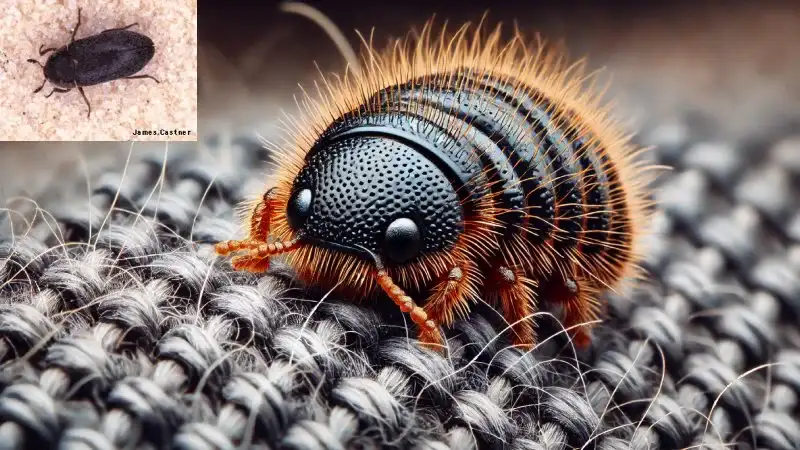Baby black carpet beetles are the larvae of adult black carpet beetles, tiny pests commonly found in homes, particularly in areas where natural fibers are present. These larvae are known for their destructive feeding habits, causing significant damage to fabrics, carpets, and other household items. While the adult beetles primarily feed on pollen and nectar, the larvae, often referred to as “baby black carpet beetles,” feed on organic materials, including wool, feathers, and dried food.
- Baby black carpet beetles grow up to 1/4 inch in length.
- A single larvae can damage entire sections of wool carpets within weeks.
- Over 70% of infestations occur in stored fabrics or areas with food.
This article explains what baby black carpet beetles are, their size, feeding habits, how to identify and prevent infestations, and the damage they can cause.
What Are Baby Black Carpet Beetles?
Black carpet beetles (Attagenus unicolor) are part of the Dermestidae family. As adults, they are small, oval-shaped beetles that are shiny black in color. The larvae, which are the baby black carpet beetles, are often the most destructive stage in their lifecycle. These pests can be found in various indoor environments and are notorious for infesting homes, where they seek out natural fibers such as wool, leather, and even stored foods.
Identifying Baby Black Carpet Beetles
Identifying baby black carpet beetles can be tricky because of their small size and resemblance to other beetles. As larvae, they measure about 1/8 to 1/4 inch in length and are typically a dull brown or yellowish color. They are covered in tiny hair-like projections, which give them a fuzzy or bristly appearance. Unlike the adults, the larvae are not black, but their brownish coloration makes them relatively easy to spot when compared to other insects.
Lifecycle of a Black Carpet Beetle
From Egg to Adult Beetle
The lifecycle of the black carpet beetle begins when a female beetle lays her eggs in dark, undisturbed areas. These eggs hatch into larvae within a week or two, depending on the environment. The larvae feed on organic materials until they reach full maturity, at which point they pupate into adults. This process can take several months or even years, depending on the environmental conditions and available food sources.
Egg Stage
Black carpet beetles lay their eggs in hidden areas, often near natural fibers or dried foods. The eggs are tiny, white, and oval-shaped, and they are laid in clusters, which hatch into larvae within 10 to 20 days.
Larval Stage (Baby Black Carpet Beetle)
Once hatched, the larvae (baby black carpet beetle) begin to feed on organic materials, especially natural fibers like wool, silk, feathers, and leather. They can cause significant damage to carpets, clothing, and furniture during this stage. Larvae are the most destructive stage of the beetles and can live for several months before pupating.
Adult Black Carpet Beetle
After completing the larval stage, the baby black carpet beetles undergo pupation, turning into adult beetles. The adults are typically black and shiny, and they often leave the feeding areas in search of mates. The adult beetles can live for several weeks to a few months, during which they focus on reproduction.
How Long Does the Lifecycle Take?
The complete lifecycle of a black carpet beetle from egg to adult can take anywhere from a few months to a year, depending on the environmental conditions. In warmer, more humid environments, the beetles develop more quickly. However, in colder areas, they may take longer to complete their lifecycle.
Physical Characteristics of Baby Black Carpet Beetles
What Is the Actual Size of Baby Black Carpet Beetles?
The actual size of baby black carpet beetles, or larvae, is typically 1/8 to 1/4 inch long. While small, their bristly appearance makes them easy to identify when closely observed. The larvae start out very tiny but grow as they continue feeding on organic materials.
Appearance and Features of Baby Black Carpet Beetles
Unlike the adults, baby black carpet beetles (larvae) are covered with short, stiff hairs that give them a fuzzy appearance. Their bodies are elongated, segmented, and usually brown or tan in color, contrasting with the shiny black adult beetles. These larvae are equipped with strong mandibles that allow them to chew through fabrics and other organic materials, making them particularly destructive to wool, silk, and carpets.
Where Do Baby Black Carpet Beetles Live?
Common Habitats
Baby black carpet beetles are most commonly found in areas with a high concentration of organic material, such as carpets, furniture, clothing, and stored food items. They tend to prefer dark, undisturbed areas where they can feed in peace. In homes, the larvae are often found in closets, attics, under furniture, and in storage bins.
Indoors
Indoors, baby black carpet beetles are typically found in closets or attics, where clothing and fabrics are stored. They can also infest pantries, especially if dry food items are left uncovered or poorly stored.
Outdoors
Outdoors, these pests are often found in bird nests, under piles of leaves, or in animal carcasses, where they can feed on organic matter. However, they are most commonly encountered indoors when they seek shelter and food.
How They Find Shelter
Baby black carpet beetles are attracted to areas with a steady food supply, such as animal hair, feathers, or dead insects. Their ability to infest a variety of materials makes them adaptable and difficult to control once an infestation begins.
What Do Baby Black Carpet Beetles Eat?
Diet of Larvae
The primary diet of baby black carpet beetles consists of natural fibers, including wool, silk, cotton, and leather. They are also known to feed on dried food products, animal hair, and even feathers. The larvae are equipped to break down keratin, a protein found in many of these materials, allowing them to survive in environments where other pests might struggle.
Impact on Household Items
As baby black carpet beetles feed on fabrics and materials, they leave behind holes, patches, and fraying, which can seriously damage clothing, carpets, and upholstery. In severe infestations, entire sections of fabric may be destroyed. Their preference for organic materials often leads to significant financial losses for homeowners who may have to replace damaged items.
Are Baby Black Carpet Beetles Harmful?
Risks to Humans and Pets
While baby black carpet beetle do not bite humans or pets, they can cause allergic reactions in some individuals. The bristles on their bodies can irritate the skin or cause respiratory issues if inhaled. In rare cases, sensitive individuals may develop dermatitis or other allergic responses to the beetles or their droppings.
Damage to Furniture and Fabrics
The primary harm caused by baby black carpet beetles is damage to fabrics, carpets, and upholstered furniture. They are particularly attracted to natural fibers, such as wool and silk, which are commonly found in high-quality fabrics. Over time, their feeding can weaken these materials, leading to holes, tears, and general degradation.
Signs of a Baby Black Carpet Beetle Infestation
Physical Indicators
One of the most common signs of a baby black carpet beetle infestation is the presence of tiny larvae or their cast skins. The larvae shed their skin as they grow, and these exoskeletons are often found in areas where the larvae have been feeding. Additionally, you may notice small, round holes in your carpet or clothing, which are a result of their feeding.
Common Locations to Check
Check areas where fabrics or food are stored, such as in closets, attics, basements, or pantries. They can also be found in hidden areas behind furniture, under rugs, or inside storage containers. Regular inspections of these spaces can help you catch an infestation early before it causes significant damage.
How to Get Rid of Baby Black Carpet Beetles
Preventive Measures
To prevent infestations, regular cleaning is essential. Vacuum carpets and upholstered furniture frequently, and wipe down surfaces where larvae might feed. Seal food items in airtight containers and ensure that natural fibers are stored in plastic bags or sealed boxes.
DIY Methods to Eliminate Them
You can eliminate baby black carpet beetle by using natural deterrents such as cedar oil or diatomaceous earth. These substances can disrupt the larvae’s feeding habits and make it difficult for them to thrive. Additionally, using a vacuum with a HEPA filter can help remove larvae, eggs, and larvae skins from your home.
Professional Pest Control Options
For large infestations, it is recommended to hire a professional pest control service. They can use more potent pesticides and other treatments to eradicate the pests from your home and prevent future infestations.
Preventing Baby Black Carpet Beetle Infestations
Regular Cleaning and Maintenance
Vacuuming regularly, particularly in areas where fabrics are stored, is essential to prevent an infestation. Pay extra attention to areas like under furniture, inside closets, and in corners of rooms.
Proper Storage of Fabrics and Food
Store clothing and fabrics in sealed containers to keep them safe from baby black carpet beetle. Additionally, make sure food is properly stored in airtight containers to prevent these pests from having easy access to food sources.
Myths About Baby Black Carpet Beetles
Many people mistakenly believe that black carpet beetles only infest dirty homes, but this is not the case. These pests can thrive in both clean and unclean environments, as long as they have access to organic materials to feed on. Regular cleaning and maintenance can reduce the chances of an infestation, but it does not guarantee that beetles will not appear.
Conclusion
Baby black carpet beetles may be small, but their ability to cause damage to fabrics and other organic materials makes them a serious problem for homeowners. By understanding their lifecycle, appearance, and feeding habits, you can take the necessary steps to prevent and eliminate these pests before they cause significant damage to your belongings.
FAQs
Q1: What Do Baby Black Carpet Beetles Look Like?
A: Baby black carpets are brown or yellowish larvae with bristly bodies, measuring 1/8 to 1/4 inch in length.
Q2: How Big Are Baby Black Carpet Beetles?
A: The actual size of baby black carpet is about 1/8 to 1/4 inch.
Q3: Are Baby Black Carpet Beetles Dangerous?
A: They are not harmful to humans directly but can cause allergic reactions and significant damage to household fabrics.
Q4: Can You Prevent an Infestation?
A: Yes, by regularly cleaning and properly storing food and fabrics, you can prevent infestations.
Q5: Do Black Carpet Beetles Only Live Indoors?
A: No, black carpet beetles can also be found outdoors in bird nests and under debris, but they are more commonly found inside homes.

